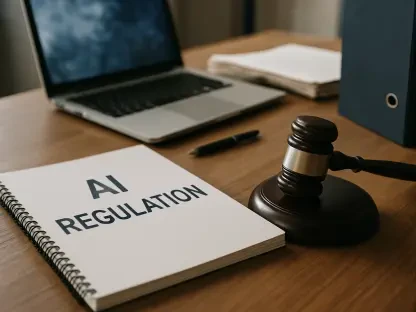Setting the Stage for Supply Chain Security
In the bustling economic hubs of Asia, a silent battle is being waged against an invisible enemy—cyber threats targeting supply chains. With the Asia-Pacific (APAC) region accounting for 34% of global cyberattacks, as reported by leading threat intelligence indexes, businesses are grappling with the stark reality that third-party suppliers often serve as the weakest link. This market analysis delves into the tightening cybersecurity regulations imposed on suppliers by Asian firms, exploring current trends, data-driven insights, and projections for the evolving landscape of third-party risk management (TPRM). The purpose is to illuminate how these shifts are reshaping market dynamics and to provide strategic guidance for stakeholders navigating this critical domain. The urgency of this issue cannot be overstated, as the security of supply chains directly impacts global trade and economic stability in one of the world’s most interconnected regions.
Unpacking Market Trends and Data in Supplier Cybersecurity
Surge in Cyber Threats and Regional Vulnerabilities
The APAC region stands at the forefront of cyber risk, with manufacturing—a backbone of many Asian economies—bearing the brunt at 40% of targeted attacks. Statistical evidence paints a grim picture: in key markets like Japan, 60% of breaches involve third-party vendors, while in Singapore, this figure climbs to 71%. This data underscores a pivotal market trend: the growing recognition of suppliers as critical entry points for cybercriminals. As firms expand their supplier networks to meet global demand, the attack surface widens, compelling a shift from traditional security measures to comprehensive TPRM frameworks that prioritize proactive defense over reactive recovery.
Corporate Initiatives Driving Stricter Standards
Across the region, major corporations are setting new benchmarks for supplier cybersecurity, reflecting a market shift toward accountability. Japanese firms, for instance, are leveraging automated tools to monitor vast supplier ecosystems. A prominent chipmaker plans to scan the security posture of its 3,000 suppliers, enforcing improvements for underperformers under the threat of contract termination. Similarly, another leading company conducts automated audits and onsite evaluations for its 500 partners. These actions signal a market preference for scalability and consistency in oversight, though they also highlight a potential disparity, as smaller suppliers may struggle to meet such rigorous demands without adequate support.
Government Policies Shaping the Competitive Landscape
Governmental intervention is another defining trend in this market, as regulatory bodies impose formal cybersecurity requirements to bolster supply chain resilience. Singapore’s push for mandatory certifications, such as national marks for vendors bidding on government contracts, exemplifies a move toward enforceable standards. This regulatory wave is altering market entry barriers, potentially sidelining smaller players who lack resources for compliance. The contrast between stringent policies in some Asian markets and more lenient approaches elsewhere raises questions about competitive equity and the long-term inclusivity of such frameworks in shaping regional trade dynamics.
Challenges of SME-Dominated Supply Chains
A unique characteristic of the Asian market is its heavy reliance on small- and medium-sized enterprises (SMEs), which form the majority of supplier networks. This structure, while fostering economic agility through just-in-time manufacturing, introduces significant cybersecurity challenges. Vetting thousands of suppliers with limited budgets for advanced security measures remains a daunting task for larger firms. Market analysts advocate for tiered risk assessments, focusing intensive scrutiny on critical suppliers while offering tailored support to smaller entities. This approach aims to balance security imperatives with operational realities, ensuring broader market participation without compromising safety.
Projections for the Future of TPRM in Asia
Technological Innovations on the Horizon
Looking ahead, technological advancements are poised to redefine the TPRM market in Asia over the next few years, particularly from 2025 to 2027. Artificial intelligence (AI) is emerging as a game-changer, with consultancy firms envisioning AI-driven systems that provide round-the-clock monitoring of supply chain risks using diverse data inputs. Such predictive tools could anticipate disruptions from cyber incidents or external shocks, offering a competitive edge to early adopters. The market is likely to see increased investment in these technologies as firms seek to stay ahead of increasingly sophisticated threats, potentially setting a global standard for supply chain security.
Shift to Continuous Monitoring Models
Another projected trend is the transition from periodic assessments to continuous monitoring, driven by the recognition that static evaluations are ill-suited to today’s fast-paced threat environment. Industry leaders emphasize the need for real-time data to assess supplier vulnerabilities dynamically. This shift is expected to gain traction across Asian markets, influencing procurement strategies and vendor relationships. Firms adopting these models may achieve greater resilience, positioning themselves favorably in a market where cybersecurity is becoming a key differentiator for business partnerships.
Evolving Regulatory and Market Dynamics
Regulatory frameworks are anticipated to tighten further, with more Asian governments likely to follow Singapore’s lead in mandating certifications and compliance standards for suppliers. This could reshape market dynamics by raising the cost of entry for non-compliant vendors, while simultaneously driving demand for cybersecurity solutions and services. Projections suggest that by 2027, a significant portion of the market may pivot toward integrated TPRM platforms that streamline compliance with diverse regional policies. This evolution will challenge firms to adapt swiftly, balancing regulatory demands with operational efficiency to maintain market share.
Reflecting on Market Insights and Strategic Pathways
Looking back, this analysis highlights the profound transformation unfolding in the Asian supply chain cybersecurity market, driven by escalating threats, corporate rigor, and regulatory mandates. The data reveals a region under siege, with supplier vulnerabilities exposing critical industries to unprecedented risks. Corporate and governmental responses, from automated monitoring to mandatory certifications, mark a decisive pivot toward fortified TPRM practices. For businesses, the path forward involves embracing scalable technologies like AI to anticipate risks, fostering collaborative relationships with SMEs to bridge compliance gaps, and aligning with emerging standards to navigate regulatory landscapes. These strategic steps promise not only to mitigate immediate threats but also to build a foundation for sustained market competitiveness in an increasingly digital and interconnected trade environment.









